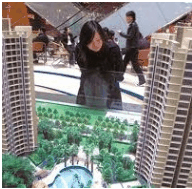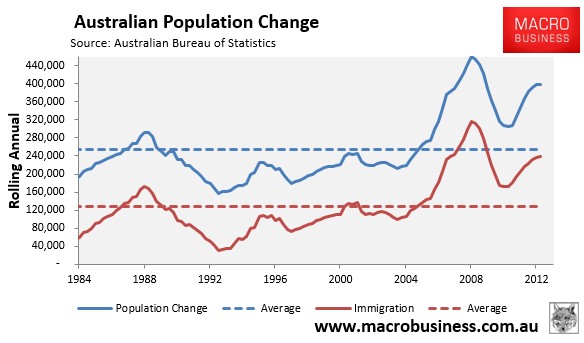
In this week’s newsletter, SQM Research’s managing director, Louis Christopher, had some stern words to say about the hysteria over Chinese investors buying up Australia’s housing stock:
The Chinese community has been part of our culture and society since the early 1800’s. It is a community that has worked hard and contributed extensively in building this country. It is a cohesive community that has helped shape the Australian way of life.
Of course, it means many Chinese living in this country are actually 3rd, 4th and 5th generation Australians. Sadly however, throughout this time, many within the Chinese community have been subjected to prejudice and fear, in particular when it comes to the real estate market.
This notion that the Chinese may buy everything up and leave the rest of us with nothing is a false prejudice that has been in existence for quite a long period of time now. Indeed, the White Australia Policy was established in 1901, with a view to minimise the number of Chinese immigrants that were coming here due to the Gold Rush.
We can look back over 100 years ago and gasp at this concept, however to some extent, many of these beliefs have continued to trickle down through the decades and are still rife within Australian society now.
This current fear that the Chinese might buy all our property once again is nothing but xenophobia.
So far, the reports have mainly come from columnists, some real estate agents and property buyers who have missed out on the purchase. I would very much like to know how these participants have managed to work out that the Chinese looking buyers they have been referring to (who were successful bidders) were not Australian citizens.
And this is the problem with this current fear – there is no hard data at all to back up the severity of the concern.
To this end, the Foreign Investment Review Board has been rather secretive in not providing actual data to the public on direct purchases of local real estate by foreign investors. They would certainly have the data to publish. But they refuse to do so. Perhaps if the department was a little more transparent, these fears, such as the ones expressed in an article by Paul Sheehan, may subside.
As you will read, all Paul Sheehan could provide in this article is hearsay. That’s literally all the evidence he had to rely on – A friend who had to compete with Chinese looking persons at a number of auctions. Plus a number quoted of $16 billion dollars in “fund flow” which no doubt covers all assets – not just real estate.
I don’t want to pick on Paul, as this is one of the many pieces we have seen from agents, property investors and columnists alike.
And I do agree, having a situation where real estate prices are pumped up by foreign investment is not good for local residents. Obviously, we need to watch for this.
However, the rules regarding foreign investment into existing property is very clear, that being – one can’t do it.
If you are a temporary resident, you need to apply to the Foreign Investment Review Board and, assuming you are given permission, you can only buy one property and you must sell that property once you leave the country (as seen by clicking here).
Foreign investors are able to buy into property developments, which I think is perfectly acceptable as that demand gives the developer the pre sales required to construct the property and therefore add to the supply of real estate in this country.
In summing it up, no one has given me hard evidence that foreigners, whether they are Chinese or not are flouting our rules. And until we do get hard evidence, I think those who are fear mongering should be seen as purely that – fear mongers.
Less sanguine are Steven Keen and John Symond, from The Australian:
Professor Steven Keen, formerly an economics head at the University of Western Sydney, went as far as to claim that Asian investors, and local investors with SMSFs, were using negative gearing to “bet on house prices going up”, causing unsustainable growth, or a bubble, in the housing sector.
John Symond agreed (though said there’s no bubble of course) and:
…criticised negative gearing, saying it was originally designed to encourage new dwellings, but that was not the outcome. “If I’ve got some expensive apartments I can negative gear them and let the taxman pay half of my million-dollar mortgage,” Mr Symond said.
In my view, concerns around foreign investment stem from two main issues.
First, as highlighted above by Louis Christopher, data surrounding foreign investment in Australian real estate is woeful. As Fairfax’s Chris Vedelago discovered first hand when trying to gain data on the extent of foreign investment, such information is next to impossible to obtain and is treated as if it was some kind of state secret. Three Freedom of Information (FOI) requests later and the best Vedelago has come up with is a stack of blanked-out and redacted pages from FIRB.
Enforcement of the foreign ownership rules seems equally inadequate. As the mythical Chodley Wontok found out when testing the efficacy of FIRB’s approval processes using bogus visa and passport information, the purported checks and balances in the system designed to prevent foreigners from purchasing pre-existing homes failed dismally, suggesting the rules are little more than window dressing.
Second, some of the frustration around foreign investment likely stems from Australia’s rapid population growth, which is being driven mostly from immigration (see next chart).

Such growth is placing strain not just on housing, but also roads, public transport networks, and other infrastructure. While it is unfortunate that Asians seem to be bearing the brunt of what is effectively a failure of government and planning, such frustrations and so-called xenophobia are only likely to grow as long as immigration levels remain high and underinvestment in infrastructure and housing continues.
Absent a substantial reduction of Australia’s immigration intake, the best way to counter concerns around foreign investment is to abandon the urban consolidation policies pursued by Australia’s state governments, which are incompatible with Australia’s high-growth population policy, act to force-up land prices, and worsen housing affordability. Rather, land supply should be deregulated – or at least significantly increased – along with the implementation of “right to build” laws that give land owners the express right to develop their land (subject to only minimum performance standards) unless there is a genuine environmental/social reason not to do so.
With genuine competition between land owners and developers, lower land prices, and an associated boost to the supply of affordable housing, concerns around foreign investment will dissipate, since domestic buyers will no longer feel shut-out and won’t be in search of a scapegoat. But as long as Australia’s governments continues to pump demand and choke supply, some buyers will continue to miss-out, frustrations will grow, and they will lash-out.

